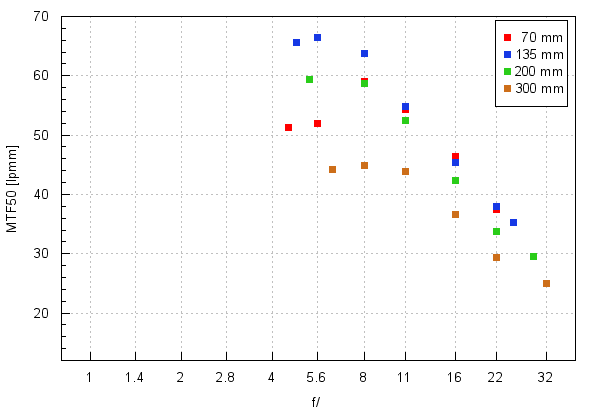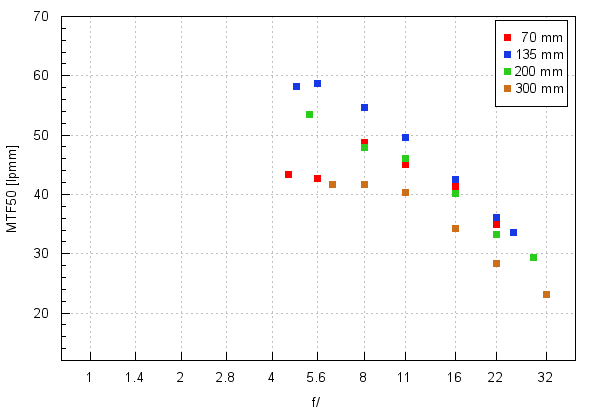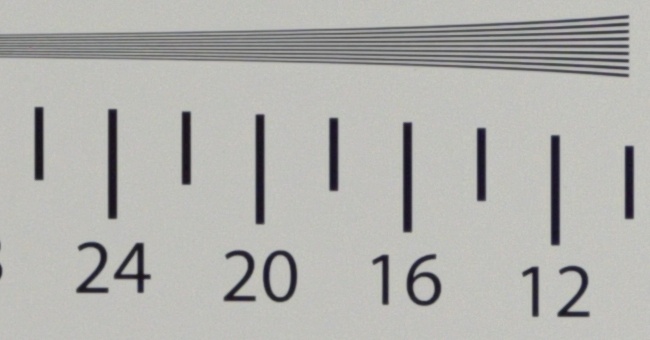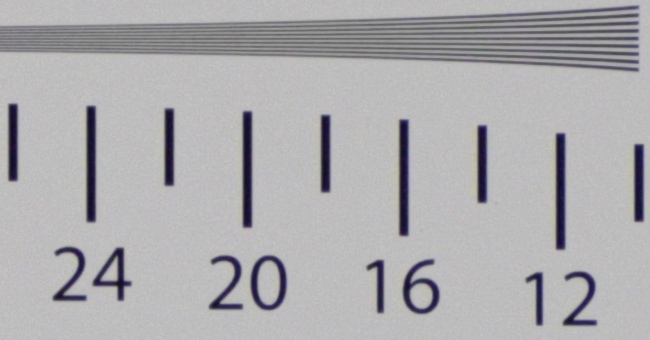Nikon Nikkor AF-P DX 70-300 mm f/4.5-6.3G ED VR
4. Image resolution
What about the maximum performance and decency level of its almost 21 Mpix sensor? During that camera test we checked its resolution performance with the help of the Sigma A 35 mm f/1.4 DG HSM, the Carl Zeiss Makro-Planar T* 50 mm f/2 ZF, and the Nikkor AF-S 24–70 mm f/2.8G ED (set at 24 mm). The maximum values reached near 83 lpmm and by f/16, an aperture which is often our point of reference when it comes to the decency level, we got results near 40 lpmm. Just before this test we also borrowed the Sigma A 85 mm f/1.4 DG HSM and tested the performance of the D500 sensor with its help independently. This time the maximum values oscillated between 82 and 83 lpmm and the results by f/16 were about 40-42 lpmm.
You can say that in the case of the sensor of the Nikon D500 the best fixed-focal lenses are able to exceed 80 lpmm, those very good can reach 75-80 lpmm and the decency level is set near 41-43 lpmm. After establishing those facts you can assess the performance of the Nikkor AF-P DX 70-300 mm VR in the frame centre. The graph below shows its resolution results.

Please Support UsIf you enjoy our reviews and articles, and you want us to continue our work please, support our website by donating through PayPal. The funds are going to be used for paying our editorial team, renting servers, and equipping our testing studio; only that way we will be able to continue providing you interesting content for free. |
- - - - - - - - - - - - - - - - - - - - - - - - - - - - - - - - - - - - - - - - - - - - - - - -
The 135 mm focal length fares the best here – the lens can reach 65-66 lpmm up from the maximum relative aperture. In other words if you take photos at that setting you will be pleased with the quality of your shots. The 70 and 200 mm focal lengths are a bit worse - in both cases the results are almost 60 lpmm ( on stopping down when it comes to the 70 mm focal length, up from the maximum relative aperture at 200 mm). As you see, so far there have been no serious reasons to complain.
The maximum focal length is the weakest here. In a wide range of apertures, from f/6.3 to f/11, you get very similar MTFs, near 43-44 lpmm. These values also our decency level so the assessment of the lens’s performance might depend on the experience of the photographer. A more advanced user, accustomed to lenses of better quality, can be a bit displeased. Beginners, after all the target audience of this lens, might still consider the images sensible enough and enjoy their photographic adventure.
Now let’s check the edge of the APS-C/DX sensor.

The ranking of focal lengths is very similar to the one we saw in the frame centre. Once again the 135 mm focal length fares the best and is beyond reproach. At 200 mm the results are a tad lower but still the lens performs sensibly well, even with the aperture wide open. At 70 mm you get sensible resolution only on stopping down the aperture and at the maximum relative aperture the results are bordering on the decency level. The 300 mm focal length is a tad below that level but in that place you really shouldn’t expect any fireworks.
To sum up, taking the price of the tested lens into account, we don’t have almost any reasons to complain. Of course you might wish for a tad better results at 300 mm but you should remember that even ten years ago 70-300 mm lenses of higher quality experienced similar problems with providing good images at the maximum relative aperture ant the maximum focal length. With this new Nikon lens you get a very decent performance for a very moderate price and, I suppose, every amateur photographer who buys this device won’t regret their purchase and enjoy their shooting.
At the end, traditionally, we present crops taken from photos of our resolution testing chart which were saved as JPEG files.
| NikonáD500, JPEG, 135ámm, f/5.6 |
 |
| NikonáD500, JPEG, 300ámm, f/6.3 |
 |






